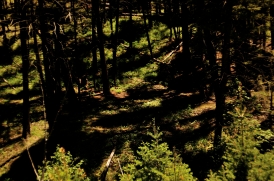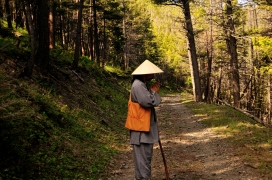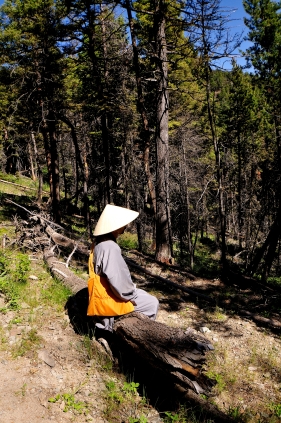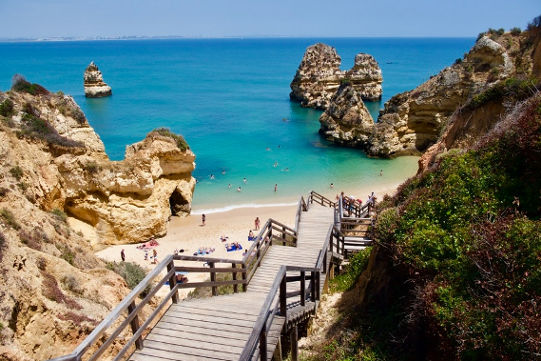Nature is a place in which we can experience rebirth of mind, body and spirit. But just putting on your hiking shoes and tuning your I-phone or I-pod to your favorite beats is not what I am taking about....
Nature is a place in which we can experience rebirth of mind, body and spirit. But just putting on your hiking shoes and tuning your I-phone or I-pod to your favorite beats is not what I am taking about. What I am talking about is taking the practice out of the meditation hall and using it in a natural non-man-made setting. It does not always mean that you have to find high mountain peaks or deep mountain valleys, but rather someplace that is not traveled so often and is peacefully nature. It could be a walk through a thicket of spruce or cottonwood in the neighborhood park, along river or creek near your home or even a stroll along the beach. Or possible is you have a large plot of land or a large garden there you have it. This is the first thing that one needs to find to start the practice of Mountain Liturgy (or Natural Liturgy). Second one should cleanse their mind of negative thoughts and feelings, if you can from any thoughts and feelings perfect, if not perfect too. I use a breathing technique in which I concentrate on my breathing.
Cleansing Breathe:
Stand straight and fully erect, keeping your shoulders set back and stomach in.
Place your hands, palms touching your abdomen, one on each side of your navel.
Breathe in through your nose, letting your chest fill and expand, exhale through mouth deflating your lungs.
Concentrate on you breathing, Inhale should be about four seconds, holding breathe should be about six seconds and the exhale should be around eight seconds and the point between exhale and inhale should be about four seconds. Repeat this ten to fifteen times.
This technique is use to one help exercise the lungs and abdomen and two you slow the wondering mind so the one may be able to experience nature in full mindfulness.
What should you wear? Well that is up to you for the most part. If you are making this apart of you practice then please wear something comfortable, loose fitting clothes, a good hat, good shoes and a walking stick (including if where your walking is rocking and rough). Now if you are a student who is preparing to do a pilgrimage, I would advise taking to you teacher or institute, because each sect, group and or rank has different rules. At least in my case, for lay and non-Buddhist practitioners that wish to do a mountain liturgy I just require and open mind, wear what is comfortable and open yourself up. For monks, nuns, and priest it depends on their order�s rules. That being said formal students of mine to whom in the future who do wish to seek the monastic life or priesthood, a simple monastic work outfit, a hat to cover the head, zori or sandles (of decent quality), walking staff, a monks bag and to be humble.
Now this practice is free for all to use. It follows in many way the daily liturgy, only this time you are walking in mindfulness. Now if you are non-Buddhist it is okay, if you feel comfortable just doing simple contemplation and meditations you can, also you can replace the Heart Sutra and Kannon Sutra with a personal prayer of your own or own you have already learned. This practice it for all of us. To bring back into balance our heart, mind and body.

Ryoo Zan An Mountain Liturgy�
Simple Practice:
Three deep bows toward the trail or path you are getting ready to start down.
Light incense
Three more deep bows.

Consider the Repentance Chant. Remember to keep you breathing as your step, even and smooth. The first place that feels right to you, that stirs something deep down make an offering of incenses, Bow Deeply completing the Repentance Chant, Three Refuges and Fours Vows section. Before continuing on your way after you have complete the recitations make gassho and bow deeply again.


Repentance Chant
Verse of Atonement
All my ancient, twisted Karma,
From beginningless greed, hate, and delusion,
Born through body, speech and mind,
I now fully avow
Three Refuges
One deep bow after each sentence:
I take refuge in Buddha.
I take refuge in Dharma.
I take refuge in Sangha.
Four Vows�
Repeat 3xs
To save all sentient beings,though beings be numberless,
To transform all delusions, though delusion is inexhaustible,
To perceive Reality, though Reality is boundless,
To attain the Enlightened Way, a way non-attainable.
Namu Daishi Henjo Kongo
Namu Daishi Henjo Kongo
Namu Daishi Henjo Kongo
Coming to the right place(s) find a comfortable but not to comfortable and start to either meditate or contemplate. If you have time, which I hope you do, then do both. Then using the same place or even on your return walk (only if you have it memorized) you can recite the Heart Sutra (Hannya Shingyo) and the Kannon Sutra.

Meditation
The time amounts of each is variable depending on your physical ability. Please do not strain yourself. If you cannot do the following time allotments shorten them up and slowly work your ways up.
15-30 minutes of meditation
10 minutes of slow walking meditation)
15-30 minutes of contemplation
Heart Sutra: Hannya Shingyo
(Japanese)
Maka Hannya Haramita Shingyou
Kan Ji Zai Bo Satsu Gyo Jin Hannya Hara Mita Ta Ji Sho Ken Go On Kai Ku Do I Sai Ku Yaku Sha Ri Shi Shiki Fu I Ku Ku Fu I Shiki Shiki Soku Ze Ku Ku Soku Shiki Ju So Gyo Shiki Yaku Bu Nyo Ze Sha Ri Shi Ze Sho Ho Ku So Fu Sho Fu Metsu Fu Ku Fu Jo Fu Zo Fu Gen Ze Ko Ku Chu Mu Shiki Mu Ju So Gyo Shiki Mu Gen Ni Bi Ze Shin Ni Mu Shiki Sho Ko Mi Soku Ho Mu Gen Kai Nai Shi Mu I Shiki Kai Mu Mu Myo Yaku Mu Mu Myo Jin Nai Shi Mu Ro Shi Yaku Mu Ro Shi Jin Mu Ku Shu Metsu Do Mu Chi Yaku Mu Toku I Mu Sho Tok Ko Bo Dai Satta E Hannya Hara Mita Ko Shin Mu Kei Ge Mu Kei Ge Ko Mu U Ku Fu On Ri Issai Ten Do Mu So Ku Gyo Ne Han San Ze Sho Butsu E Hannya Hara Mita Ko Toku A Noku Ta Ra San Myaku San Bo Dai Ko Chi Hannya Hara Mita Ze Dai Jin Shu Ze Dai Myo Shu Ze Mu Jo Shu Ze Mu To Do Shu No Jo Issai Ku Shin Jitsu Fu Ko Ko Setsu Hannya Hara Mita Shu Soku Setsu Shu Watsu Gya Tei Gya Tei Ha Ra Tei Hara So Gya Tei Bo Ji Sowa Ka Hannya Shin Gyo
(English)
In the near future I upload an audio on the Hannya Haramita Shingyo. If you wish to use this Japanese version and have question on pronunciations please contact me and I will be more than happy to help you with recitation.
Avalokiteshvara bodhisattva when practicing deeply the prajna paramita perceived that all five skandas are empty and was saved from all suffering and distress.
O Shariputra, form does not differ from emptiness; emptiness does not differ from form, that which is form is emptiness; that which is emptiness, form. The same is true of feelings, perceptions, impulses, consciousness.
O Shariputra, all dharmas are marked with emptiness; they do not appear, nor disappear, are not tainted not pure, do not increase nor decrease.
Therefore in emptiness, no form, no feelings, no perceptions, no impulses, no
consciousness, no eyes, no ears, no nose, no tongue, no body, no mind; no color, no sound, no smell, no taste, no touch, no object of mind; no realm of eyes and so forth until no realm or mind consciousness; no ignorance and also no extinction of it, and so forth until no old age and death and also no extinction of them; no suffering, no origination, no stopping, no path, no cognition, also no attainment.
With nothing to attain the bodhisattvas depends on prajna paramita and the mind is no hindrance. Without any hindrance no fears exist; far apart from every perverted view the bodhisattva dwells in nirvana.
In the three worlds all Buddhas depend on prajna paramita and attain unsurpassed complete perfect enlightenment.
Therefore know the prajna paramita is the great transcendent mantra, is the great bright mantra, is the utmost mantra, is the supreme mantra, which is able to relieve all suffering and is true, not false. So proclaim the prajna paramita mantra, proclaim the mantra that says:
�GATE GATE, PARAGATE, PARASAMGATE BODHI! SVAHA!�
Kanzeon Sutra in 10 lines
Kanzeon! Veneration to the Buddha!
With Buddha I have origin;
With Buddha I have affinity;
Affinity with Buddha, Dharma, Sangha;
Constancy, joy, self, and purity.
Mornings, my thought is Kanzeon;
Evenings, my thought is Kanzeon.
Thought after thought arising in mind.
Thought after thought not separated from mind.
Upon finishing your walking liturgy turn back to the path or trail you are leaving and put your hands in Gassho and close by reciting the Transfer of Merit Chant and Close with three deep bows.
Transfer of Merit Chant
We pray to all the Buddhas, all the Bodhisattva-Mahasattvas in the ten quarters, of the past, present, and future, and to Mahaprajna-paramita, that by virtue of this merit universally prevailing, not only we but all beings shall equally attain Buddhahood.
Namu Daishi Henjo Kongo
Closing
Three low bows
So why do I always say three deep bow, three represents our Refuge Vow, We Bow is appreciation and respect to Buddha, We Bow is appreciation and respect to Dharma, We Bow is appreciation and respect to Sangha. This is why.
Should you have any questions or are looking for formal training please feel free to contact me through the contact section of this blog.
Namu Daishi Henjo Kongo
?? (Kozou)










